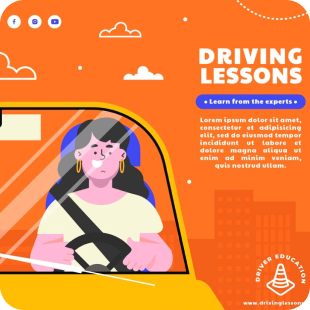- G1 Practice Test Quiz 1 (Signs 1)1
- G1 Practice Test Quiz 2 (Signs 2)2
- G1 Practice Test Quiz 3 (Rules 1)3
- G1 Practice Test Quiz 4 (Rules 2)4
- G1 Practice Test Quiz 5 (Rules 3)5

Tria test G1
Test 3
Our development team has created this powerful online testing engine to help you quickly prepare for the driving regulations exam.
Why should drivers signal when turning left or right?
A. All options are correct
B. To inform oncoming traffic of their intention
C. To inform traffic behind them of their intention
D. To inform pedestrians of their intention

A painted white arrow on a lane means:
A. Indicates where you must stop
B. As soon as there are no obstacles in your way, go to the farthest left or right lane
C. You are only allowed to proceed in the direction indicated
D. Stop before the arrow and yield to pedestrians

If an emergency vehicle with its lights and sirens activated is moving on a two-way road, what is the duty of other drivers according to the law?
A. Increase their speed and move out of the way
B. Continue at the same speed
C. Signal the driver to pass
D. Steer the vehicle to the far right and stop if necessary

When a speed limit sign is not posted, what is the maximum speed in cities, towns, and villages?
A. 50 kilometers per hour
B. 40 kilometers per hour
C. 30 kilometers per hour
D. 60 kilometers per hour

If a driver is arrested for the first time with a blood alcohol concentration of...
A. 0.18-0.08
B. 0.08-0.07
C. 0.10-0.08
D. 0.08-0.05

A flashing yellow light at an intersection:
A. Allows drivers to continue at their previous speed
B. If drivers intend to turn left, they must stop
C. Warns drivers to proceed with caution
D. If drivers intend to turn right, they must stop

When driving with headlights on, when is a driver required to use low beams?
A. Within 300 meters of an oncoming vehicle
B. Within 30 meters of an oncoming vehicle
C. Within 50 meters of an oncoming vehicle
D. Within 150 meters of an oncoming vehicle

How many occupants must a vehicle have to use the High Occupancy Vehicle (HOV) lane on intercity highways?
A. At least two people
B. 3 or more people
C. Any vehicle that exceeds the speed limit
D. 4 or more people

Is there a seatbelt law in Ontario?
A. No
B. Yes
C. Only when driving in urban areas
D. Only when driving on highways

When encountering a stop sign, what must a driver do before entering the intersection?
A. Stop and proceed only if sure there is no danger
B. Reduce speed and proceed if sure there are no obstacles
C. Reduce speed, honk, and proceed
D. Stop, honk, and proceed

Are drivers responsible for ensuring their passengers wear seatbelts?
A. Only when passengers are seated in the back
B. Only when passengers are seated in the front
C. Only when passengers are over 16 years old
D. Only when passengers are under 16 years old

On roads with a divider in the middle, when must drivers stop for a school bus?
A. On roads with a divider, stopping is not required
B. Whenever approaching the bus
C. When stopped behind the bus with its flashing lights on
D. Whenever the bus stops

Why must an emissions test be performed on a vehicle?
A. Because the vehicle registration needs to be renewed
B. Because the vehicle may pollute the environment
C. Because the vehicle has aged
D. All options are correct

When are drivers required to turn on their vehicle's headlights?
A. There is no specific time
B. Half an hour before sunset and half an hour after sunrise, and whenever there is insufficient light to identify objects from 150 meters away
C. From sunset to sunrise
D. From sunset to sunrise, and whenever there is insufficient light to identify objects from 150 meters away

At a roundabout, who has the right of way?
A. The driver entering from the left
B. The driver entering from the right
C. The driver who entered the roundabout first
D. The driver who is entering the roundabout

When a driver intends to turn right, which lane should they be in?
A. The closest lane to the right of the road
B. The closest lane to the center line of the road
C. The lane approaching from the left
D. The closest lane to the left of the road

When can drivers use the right shoulder of the road?
A. Anytime they can pass a vehicle turning left, regardless of whether the right shoulder is smooth or rough
B. Whenever they can do so safely
C. Never
D. Only when the right shoulder is smooth, they can pass a vehicle turning left

If your mobile phone rings while driving:
A. Ask passengers to answer your phone
B. All options are correct
C. Wait for the call to go to voicemail
D. Pull over, park, and then use your mobile phone

If the traffic light changes from green to yellow as the driver enters the intersection, what must the driver do?
A. Accelerate to leave the intersection as quickly as possible
B. Must stop; but if stopping is dangerous, they should proceed with caution
C. Maintain current speed and pass through the intersection
D. Pull over, park, and then use your mobile phone

When there is no danger, passing on the right:
A. Is allowed if the street or highway has two or more lanes for vehicles moving in the same direction
B. Is never allowed
C. Is allowed if driving on the road shoulder is possible
D. Is allowed if driving on the road shoulder is possible

To legally make a U-turn, how far must a driver see in both directions?
A. 50 meters
B. 250 meters
C. 100 meters
D. 150 meters

When parking on an uphill with a curb:
A. The front wheels should be parallel to the curb
B. Turn the steering wheel to the left
C. As long as the handbrake is engaged, the direction of the wheels does not matter
D. Turn the steering wheel to the right

When approaching a yield sign, what must drivers do?
A. Reduce speed, stop if necessary, and only proceed if there are no obstacles
B. Stop and then quickly join the traffic ahead
C. Increase speed and merge into the traffic ahead
D. Stop and then slowly join the traffic ahead

When turning right is permitted at a red light, what must drivers do before entering the intersection?
A. Slow down and turn with a signal
B. Stop and then merge into traffic
C. Come to a complete stop and wait until there are no obstacles or dangers before proceeding
D. Slow down and proceed with caution

A flashing red light at an intersection:
A. Slow down and proceed with caution
B. Drivers must come to a complete stop and proceed only if there is no danger
C. The traffic light is malfunctioning; proceed with caution
D. Slow down and yield to vehicles coming from the left or right if necessary

When towing a trailer or boat, what should the driver not carry in the trailer or boat?
A. People
B. Flammable materials
C. Camping gear
D. Weapons

What do two solid lines on the road indicate?
A. It means the lane you are in is ending or is an exit lane, and you must change lanes
B. Stop before reaching the lines and yield to pedestrians
C. Keeps traffic away from obstacles like bridge supports or concrete barriers
D. The path is not safe for travel

When the light is green at an intersection, who has the right of way legally?
A. Drivers intending to turn left
B. Drivers intending to turn right
C. Pedestrians crossing against the light
D. Pedestrians crossing with the light

When using headlights is necessary, how far behind another vehicle should a driver use low beams?
A. From 60 meters away
B. From 100 meters away
C. From 120 meters away
D. From 30 meters away

When passing a cyclist, what should be the minimum distance?
A. Three meters between the vehicle and the cyclist
B. Five meters between the vehicle and the cyclist
C. One meter between the vehicle and the cyclist
D. Two meters between the vehicle and the cyclist

If two vehicles arrive at an uncontrolled intersection at nearly the same time, who has the right of way?
A. Neither
B. The vehicle to the right of the other vehicle
C. The vehicle traveling at a higher speed
D. The vehicle to the left of the other vehicle

What is the driver's duty when entering a highway?
A. Drive slowly and be prepared to stop for the freeway traffic
B. Stop in the acceleration lane and wait for a clear path before entering the freeway quickly
C. Signal, increase speed, and merge smoothly into traffic
D. Slow down and suddenly enter the freeway

A person whose driver's license is suspended:
A. Can only drive with a licensed driver accompanying them
B. Has no right to drive under any circumstances
C. Can only drive on the way to work
D. Can only drive in emergencies

A driver intending to go straight who encounters a red light at an intersection must do what?
A. Stop and yield to pedestrians, then proceed with caution
B. Stop and wait for the green light, then proceed if there are no obstacles
C. Slow down and proceed if there are no obstacles
D. Stop and proceed if there are no obstacles

When a public transport vehicle (tram) is picking up or dropping off passengers where there is no designated area, what must drivers behind the public transport vehicle do?
A. Honk and proceed with caution
B. Stop behind the rear door of the public transport vehicle and proceed with caution
C. If there are no obstacles, pass on the left
D. Stop at least two meters from the rear door of the public transport vehicle where passengers are boarding or alighting

When approaching a stop sign, what must the driver do before entering the intersection?
A. Stop and proceed if sure there is no danger
B. Slow down and proceed if sure there are no obstacles
C. Slow down, honk, and proceed
D. Stop, honk, and proceed

On two-way roads, before turning left, which lane must the driver enter?
A. As long as the driver signals, lane choice does not matter
B. The closest lane to the right side of the road
C. The closest lane to the left side of the road
D. The rightmost lane relative to the center line of the road

When approaching an intersection that has no stop line or crosswalk, where should the driver stop?
A. At the edge of the intersection
B. Slightly inside the intersection
C. Right before the stop sign
D. Right next to the stop sign

.png)

